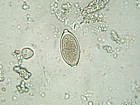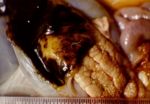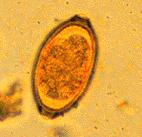Difference between revisions of "Category:Trichinelloidea"
Jump to navigation
Jump to search
| Line 6: | Line 6: | ||
[[Image:Trichuris vulpis.jpg|thumb|right|150px|''Trichuris vulpis'' - Courtesy of the Laboratory of Parasitology, University of Pennsylvania School of Veterinary Medicine]] | [[Image:Trichuris vulpis.jpg|thumb|right|150px|''Trichuris vulpis'' - Courtesy of the Laboratory of Parasitology, University of Pennsylvania School of Veterinary Medicine]] | ||
[[Image:Capilaria.jpg|thumb|right|150px|''Capilaria'' - Courtesy of the Laboratory of Parasitology, University of Pennsylvania School of Veterinary Medicine]] | [[Image:Capilaria.jpg|thumb|right|150px|''Capilaria'' - Courtesy of the Laboratory of Parasitology, University of Pennsylvania School of Veterinary Medicine]] | ||
| − | + | ||
| − | |||
The common feature of members of this group is that the oesophagus is a column of doughnut-shaped cells. They are only distantly related to the other nematode groups and so drugs developed primarily for controlling strongyle and ascarid worms are often less effective against these. | The common feature of members of this group is that the oesophagus is a column of doughnut-shaped cells. They are only distantly related to the other nematode groups and so drugs developed primarily for controlling strongyle and ascarid worms are often less effective against these. | ||
| Line 15: | Line 14: | ||
#''[[Capillaria]]'' | #''[[Capillaria]]'' | ||
#''[[Trichinella]]'' | #''[[Trichinella]]'' | ||
| − | |||
| − | |||
| − | |||
| − | |||
| − | |||
| − | |||
| − | |||
| − | |||
| − | |||
| − | |||
| − | |||
| − | |||
| − | |||
Revision as of 11:11, 26 April 2010
| This article is still under construction. |
The common feature of members of this group is that the oesophagus is a column of doughnut-shaped cells. They are only distantly related to the other nematode groups and so drugs developed primarily for controlling strongyle and ascarid worms are often less effective against these.
There are just three genera of veterinary importance:
- Trichuris (the whipworms)
- Capillaria
- Trichinella
Pages in category "Trichinelloidea"
The following 5 pages are in this category, out of 5 total.



